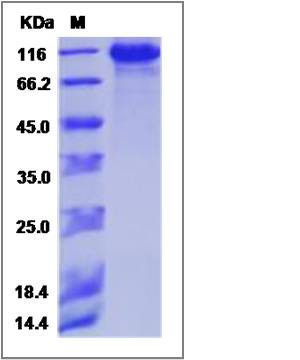Mouse MDGA2 / MAMDC1 Protein (His Tag)
6720489L24Rik,9330209L04Rik,Adp,Mamdc1
- 100ug (NPP3400) Please inquiry
| Catalog Number | P50431-M08H |
|---|---|
| Organism Species | Mouse |
| Host | Human Cells |
| Synonyms | 6720489L24Rik,9330209L04Rik,Adp,Mamdc1 |
| Molecular Weight | The secreted recombinant mouse MDGA2 comprises 910 amino acids and has a predicted molecular mass of 103 kDa. As a result of glycosylation, the apparent molecular mass of rm MDGA2 is approximately 110-120 kDa in SDS-PAGE under reducing conditions. |
| predicted N | Pro 26 |
| SDS-PAGE |  |
| Purity | > 90 % as determined by SDS-PAGE |
| Protein Construction | A DNA sequence encoding the mouse MDGA2 isoform 1 (P60755-1) without the propeptide (Met 1-Asp 924) was expressed, fused with a polyhistidine tag at the C-terminus. |
| Bio-activity | |
| Research Area | Neuroscience |Cell Adhesion Proteins |Membrane Proteins |
| Formulation | Lyophilized from sterile PBS, pH 7.4 1. Normally 5 % - 8 % trehalose and mannitol are added as protectants before lyophilization. Specific concentrations are included in the hardcopy of COA. |
| Background | Mouse MAM domain-containing glycosylphosphatidylinositol anchor protein 2, also known as MAM domain-containing protein 1, MDGA2 and MAMDC1, is a cell membrane protein which contains six Ig-like (immunoglobulin-like) domains and one MAM domain. Analyses of the full-length coding region of MDGA1 and MDGA2 indicate that they encode proteins that comprise a novel subgroup of the Ig superfamily and have a unique structural organization consisting of six immunoglobulin (Ig)-like domains followed by a single MAM domain. Biochemical characterization demonstrates that MDGA1 and MDGA2 proteins are highly glycosylated, and that MDGA1 is tethered to the cell membrane by a GPI anchor. The MDGAs are differentially expressed by subpopulations of neurons in both the central and peripheral nervous systems, including neurons of the basilar pons, inferior olive, cerebellum, cerebral cortex, olfactory bulb, spinal cord, and dorsal root and trigeminal ganglia. The similarity of MDGAs to other Ig-containing molecules and their temporal-spatial patterns of expression within restricted neuronal populations, for example migrating pontine neurons and D1 spinal interneurons, suggest a role for these novel proteins in regulating neuronal migration, as well as other aspects of neural development, including axon guidance. |
| Reference |
